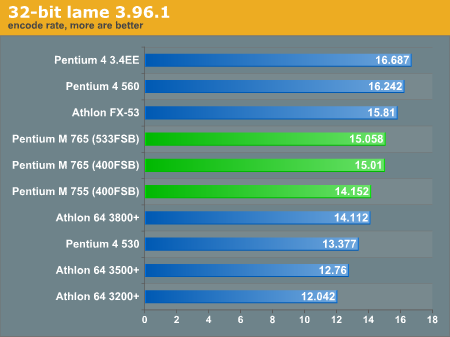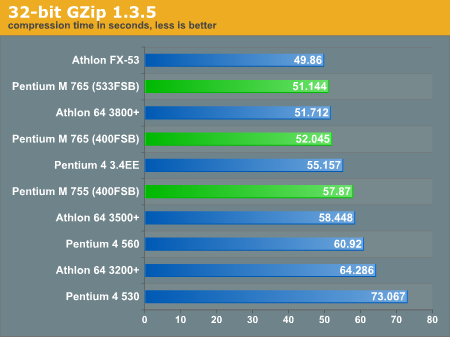Linux and the Desktop Pentium M: Uncommon Performance
by Kristopher Kubicki on December 24, 2004 12:00 PM EST- Posted in
- Linux
Content Creation
Below, we compiled lame 3.96.1 without any additional optimizations and then used the following command on a 800mb .wav file.# lame sample.wav - b 192 - m s - h - >/dev/null
The file is sent to stdout, which is then directed to /dev/null. We do not want the hard drive to throttle our mp3 encoding if possible, even if we are just immediately destroying it.

Next, we used the SuSE 9.1 Pro i686 bzip2 and gzip RPMs for this portion of the analysis. We recompile both binaries from scratch later to illustrate the effect of the compiler optimizations. The 800MB test file from the lame benchmark above was compressed and then timed using the command below.
# time gzip -c sample.wav > /dev/null

We compiled MPlayer 1.0pre5 from source without any optimizations. The benchmark command that we ran is below:
# time mencoder sample.mpg -nosound -ovc lavc vcodec=mpeg4:vpass=2 -o sample.avi











47 Comments
View All Comments
bhtooefr - Saturday, December 25, 2004 - link
Problems on the John the Ripper section:DES: Where's the 755?
MD5: Where's the 400MHz FSB 765?
Blowfish: Where's the 533MHz FSB 765?
Also, for anyone who wants to know what the heatsink IS, x86-Secret reviewed this before the heatsink was available, and they used a MicroCool northbridge heatsink.
FWIW, I don't know why nobody's coupled this thing to an i865/875. It's definitely possible, as Shelton (0K L2 Banias) has been coupled to an i845, and Banias has been coupled to an E7501. And, the fact that Alviso is "i915GL" says a lot. Mobo makers should be able to simply rework the traces leading to the socket, and reuse their P4 board designs for a P-M board design. Or, if they're REALLY lazy, they could just make an adaptor - put the processor in it, and drop it in the socket.
ImSoHighRightNow - Saturday, December 25, 2004 - link
"Encode rate, more are better"? Some encoding rates can't be "more" than other encoding rates. They can be HIGHER, but not "more". I would suggest "Encoding rates, higher is better"You know what you need? A grammar handbook. Nothing annoys me more than someone who can't conjugate "to be" correctly. I learn conjugations for other languages, the least you can do is learn conjugations for one verb in English. Thanks
ImSoHighRightNow - Saturday, December 25, 2004 - link
"Rendering time in seconds, less are better"Shouldn't that read more like "Rendering time in seconds, fewer is better" or "Rendering time, a shorter amount of time is better"? At least something remotely grammatical would be preferable. Thanks
miketheidiot - Saturday, December 25, 2004 - link
dothan will need work before its ready for desktop. Simple as that. And make it cheaper two, that would be good. $500 + $250 for a mobo is quite a bit, even if it does OC well.DrMrLordX - Friday, December 24, 2004 - link
Looks like the Dothan falls flattest when it's faced with multiple concurrent threads. Dual-core Dothan solutions might alleviate some of that problem, but, perhaps this is one of the reasons why Intel has been rather shy about pushing multi-core Pentium Ms for the desktop?Googer - Friday, December 24, 2004 - link
It seemed to me that the extra performance 133mhz that the 533 bus provides is rather small. My suggestion is couple this with an 875 or 865 chipset @400mhz and let dual channel memory add the needed performance boost. Its probably the cheapest and most effective way to increase the performance of Pentium M.Pannenkoek - Friday, December 24, 2004 - link
I believe that the price of the processor tested should have a more prominent position in the whole test. It's, after all, about the price/performance ratio for most of the consumers.If you plan on testing GCC vs ICC then I recommend to visit http://www.coyotegulch.com (though the site is "temporarily unavailable"), where you can find comparisons between the compilers, compile settings and more.
The focus of the tests on the site is on scientific applications/algorythms which fit in cache, and is therefore more about how many micro-optimizations are not missed. Which explains why results can vary so much; and also why the ICC compiler, made by Intel for Intel processors, can be sometimes a lot faster than GCC, which does not share the intimate knowledge of the inner working of those processors and targets a zillion other architectures as well...
sprockkets - Friday, December 24, 2004 - link
I wish though you included pics of the fully assembled system. I would like to see that HSF, since it appears AOpen simply uses a 478 type heatsink bracket. But looking at the board at newegg.com, the Aopen board comes with the heatsink, and has DUAL Marvell Gbe, plus it has a SATA controller on it as well, and costs $14 less.MDme - Friday, December 24, 2004 - link
Anand and co: when will you guys do a full review of this chip against P4 and A64 across the different applications, games, etc? that would be a great gift to your readers at AT.JustAnAverageGuy - Friday, December 24, 2004 - link
Page 6:"We also took the same POV-Ray benchmark and ran it against the Pentium M clocked at speeds from 1.0GHz to 2.4GHz."
Should read 1.6GHz
[shake 3.5c]"Although it holds up well against an Athlon 64 3200+"
Doesn't seem like it. It took over 12 minutes longer.